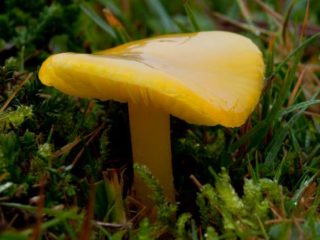Content
A bright, beautiful mushroom from the Hygrophoraceae family - hygrocybe scarlet. The Latin name of the species is Hygrocybe coccinea, Russian synonyms are hygrocybe crimson, red. The basidiomycete received its self-explanatory name due to the bright color of the entire surface.
What does Hygrocybe scarlet look like?
The fruiting body consists of a small cap and a thin stalk. They are painted crimson. The plates are slightly different and have a yellow tint.
The cap of young specimens is bell-shaped. Over time, it becomes prostrate and a small depression appears in the center. Its diameter does not exceed 5 cm.The edges are thin and crack in older fruiting bodies.

The color can have all shades of scarlet or orange, it depends on the place of growth, weather conditions, and the age of the individual specimen.
The skin covering the surface consists of small bubbles. The pulp of the upper part of the fruit body is thin, orange with a yellow tint. It has no pronounced taste or smell. Does not change color when broken.
The plates are wide, thickened, can branch, and are rarely located. In old mushrooms, they grow to the stem with teeth. Their color repeats the color of the fruiting body.
The spores are oblong, elongated, ovoid or ellipsoidal, smooth. White spore powder.

The leg does not grow more than 8 cm in length and 1 cm in diameter, it is thin, fibrous, solid, cylindrical in shape
In older mushrooms, it may become distorted as it grows. On the sides its shape is slightly compressed. The upper part is red, becomes lighter towards the bottom and becomes yellow. There are no rings on the stem.
Where does Hygrocybe scarlet grow?
These purple basidiomycetes are found in the humid forests of Europe and North America, in clearings densely covered with grass and well lit by sunlight. In Russia, Hygrocybe scarlet is rare, mainly in the European part of Russia.
Scarlet caps can also be found in meadows with depleted soil, where other species cannot survive. Fruiting occurs from July to September. Fruiting bodies grow in small groups.
Is it possible to eat Hygrocybe scarlet?
The described species is conditionally edible, but does not have high taste qualities. The bright scarlet color often scares off lovers of quiet hunting; they believe that they have encountered a poisonous specimen. But Hygrocybe scarlet can be collected and cooked. It is usually boiled or fried.
False doubles
Many species of the Hygrophoraceae family are similar. Some of them are almost impossible to distinguish from each other. Only an experienced mushroom picker can do this.
Hygrocybe crimson
Its cap is conical or bell-shaped, dark burgundy. There is a small protrusion in the center. The diameter of the cap is several times larger than the described fellow and can grow up to 12 cm.

The leg of the twin is light, yellow and thick, the entire surface is dotted with grooves
The pulp is thick and tough, and has a strong, unpleasant odor.
Hygrocybe crimson is considered edible; mushroom pickers note its pleasant taste.
Hygrocybe oak
The mushroom has a conical elongated cap. In humid weather, its surface becomes slimy and sticky.

The color of the skin and pulp is yellow-orange
The leg is hollow, short, cylindrical in shape. Its color is light yellow, sometimes whitish spots appear.
The mushroom is not poisonous, but does not have high nutritional value. The pulp does not have a distinct aroma or taste.
Hygrocybe meadow
The mushroom has a convex, round, dense cap. The color is apricot with a red tint. The surface is oily and eventually becomes dry and cracks.

The leg is cylindrical, thick, short, tapering towards the bottom
The mushroom is edible and does not differ in high taste. When cooking, it requires a long heat treatment.
Rules for collection and use
Hygrocybe scarlet begins to be collected in mid-summer. You can find it in meadows in tall thickets of grass.
The fruit body is small and not fleshy; in order to prepare a mushroom dish, you need to work hard during the collection process.
The scarlet basidiomycete is cleaned, washed, and then boiled or fried.
The bright fruiting body is often used as a decoration for homemade mushroom dishes. Hygrocybe alaya looks especially beautiful in jars with pickled forest gifts.
Conclusion
Hygrocybe scarlet is a bright, beautiful mushroom that is rarely found in the forests of Russia. Lovers of quiet hunting are attracted to it not so much by its taste as by its spectacular appearance. But you shouldn’t ignore the purple fruiting bodies; they can be cooked with your favorite boletus or russula.








